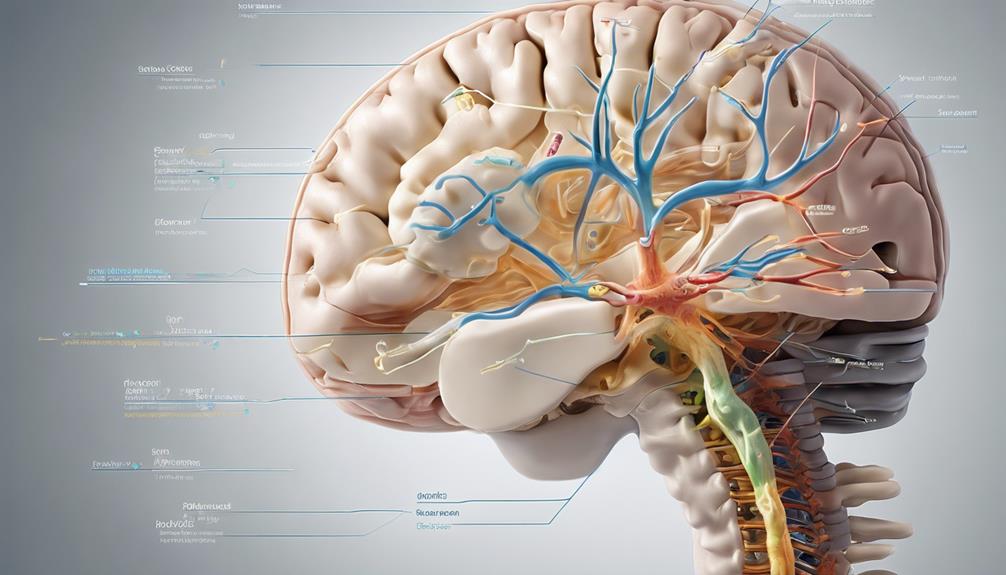Encourage movement in infants by making tummy time a priority, as it is crucial for strengthening and developing motor skills. Engaging in interactive play helps with muscle activity, coordination, and bonding with caregivers. Assist in the growth of sitting and balance skills through supervised practice on safe surfaces. Establish safe exploration areas that are free of dangers for your little one to play in. Select toys that aid in developing reaching and grasping abilities with different textures and interactive components. These activities form the basis for healthy physical activity habits in the long run. Discover more tips on promoting your baby’s motor skills and overall development.
Key Takeaways
- Engage in tummy time to build essential strength for movement.
- Use interactive play to enhance motor skills and coordination.
- Support sitting and balance development with proper supervision.
- Create a safe exploration area free of hazards for movement.
- Offer toys that encourage reaching, holding, and grasping for movement development.
Importance of Tummy Time
Engage your baby in tummy time to develop essential strength for crawling and standing. Tummy time is vital for enhancing infant motor skills, as stated by the Department of Health. By encouraging movement during tummy time, you're helping your baby build the necessary muscles for future physical activities.
The Department of Health emphasizes the significance of early intervention through activities like tummy time to support your baby's development.
To make the most of tummy time, start with short sessions and gradually increase the duration. Interacting with your baby by singing, talking, and maintaining eye contact can make tummy time more engaging. It's recommended to offer tummy time on various surfaces and positions to stimulate different muscles and promote overall motor development.
If your baby shows aversion to tummy time or experiences any difficulties, seeking guidance from a healthcare professional is advised for proper intervention and support.
Interactive Play for Motor Skills

To enhance your baby's motor skills development, interactive play offers a fun and effective way to engage their muscles and senses. By incorporating simple activities like reaching for toys, playing with soft objects, and engaging in floor play, you can support your infant's fine motor skills. Interactive play is crucial for infants and toddlers as it helps strengthen muscles, improve coordination, and enhance sensory exploration. This type of play not only fosters bonding between caregivers and infants but also promotes physical and cognitive development. Encouraging interactive play in daily routines can instill lifelong habits of physical activity and movement in your little one. Here is a table highlighting some interactive play ideas to support motor skill development:
| Interactive Play Ideas | Age Group | Benefits |
|---|---|---|
| Reaching for Toys | Infants | Enhances fine motor skills |
| Soft Object Play | Toddlers | Improves sensory exploration |
| Floor Play | Infants | Strengthens muscles |
Supporting Sitting and Balance

Encourage your infant's sitting and balance development by providing proper support and interactive play opportunities. Supporting your baby's motor skills through supervised practice is essential for their overall growth.
Use pillows or cushions to assist your baby in sitting comfortably while engaging in play. Placing toys within reach can help them develop balance and coordination. Remember, supervised practice with sitting aids can strengthen the core muscles necessary for independent sitting. Opt for safe and stable surfaces to prevent falls and injuries during these practice sessions.
Additionally, interactive play while sitting can further enhance your baby's balance and stability. As noted by pediatric experts, 'Engaging in play activities while sitting not only promotes physical development but also encourages cognitive and social skills.'
Creating a Safe Exploration Area

When setting up a safe exploration area for your baby, prioritize securing furniture to prevent tipping over and utilizing safety gates to limit access to hazardous areas.
In your child care routine, make sure that the play space is free of small objects and choking hazards, keeping them out of reach to maintain a safe environment.
Additionally, cover electrical outlets and safely tuck away cords to prevent accidents during exploration. Provide soft, padded surfaces for crawling and playing to minimize the risk of injuries.
Remember to supervise your baby closely during exploration to be able to intervene in case of potential dangers or accidents.
As emphasized by child care experts, "Creating a safe exploration area is important for your baby's development and safety," so make sure to take the necessary precautions to establish a secure environment for your little one to play and learn.
Toys for Reaching and Holding

Select toys with a variety of textures, shapes, and sizes to enhance your baby's reaching and grasping skills. Soft, lightweight toys that are easy to hold and manipulate can help infants develop their fine motor skills effectively. To encourage your baby to reach and hold onto toys, opt for interactive toys that respond to their touch or movements. These toys not only keep your baby upright but also promote hand-eye coordination and dexterity. Activities that help in improving grasping skills include providing toys that make sounds or have bright colors, attracting your baby's attention and motivating them to engage with the toy. Offering a range of toys that require different grasping techniques can further aid in your baby's development. Below is a table showcasing some examples of toys that can assist in enhancing your baby's reaching and holding abilities:
| Toy Type | Description | Benefits |
|---|---|---|
| Soft Plush Toys | Lightweight and easy to manipulate | Develops fine motor skills |
| Rattles | Make sounds and have bright colors | Captures attention and motivates reaching |
| Interactive Toys | Respond to baby's touch or movements | Enhances engagement and motivation to hold onto the toy |
Frequently Asked Questions
What Activities Encourage Physical Development in Infants?
To boost your infant's physical development, engage in tummy time for muscle strength, offer colorful toys for reaching and grasping, play interactively on the floor, create a safe exploration zone for standing, and child-proof your home for a stimulating environment.
How to Encourage a Baby to Be More Active?
To encourage your baby to be more active, engage in interactive play, provide colorful toys for reaching and grasping, offer tummy time daily, and create a safe play environment for exploration. Support milestones like standing and crawling.
How to Encourage a Baby to Push Up?
Encourage your baby to push up during tummy time by placing colorful toys just out of reach. Support their arms and chest gently to help them build strength. Celebrate each milestone in their progress.
What Type of Physical Activity Is Recommended for Infants?
For infants, a variety of physical activities are recommended, such as tummy time sessions, reaching, grasping, rolling over, and interactive play with caregivers. Providing a safe and stimulating environment with age-appropriate toys can promote movement development.
Conclusion
Tummy time, interactive play, and safe exploration areas are essential for encouraging your baby's physical development. As pediatrician Dr. Smith notes, 'These activities promote muscle strength, coordination, and cognitive skills.'
Just like a seed needs sunlight to grow, babies need movement to thrive. So, get down on the floor, engage in play, and watch your little one blossom into a strong and confident mover. Remember, every wiggle and reach is a step towards a bright and active future.










